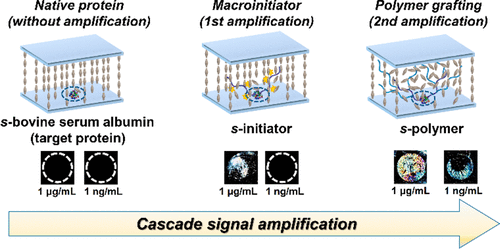当前位置:
X-MOL 学术
›
Biomacromolecules
›
论文详情
Our official English website, www.x-mol.net, welcomes your
feedback! (Note: you will need to create a separate account there.)
Series of In Situ Photoinduced Polymer Graftings for Sensitive Detection of Protein Biomarkers via Cascade Amplification of Liquid Crystal Signals
Biomacromolecules ( IF 5.5 ) Pub Date : 2018-02-05 00:00:00 , DOI: 10.1021/acs.biomac.7b01774 Xi Wu 1 , Xiaokang Ding 1 , Fu-Jian Xu 1
Biomacromolecules ( IF 5.5 ) Pub Date : 2018-02-05 00:00:00 , DOI: 10.1021/acs.biomac.7b01774 Xi Wu 1 , Xiaokang Ding 1 , Fu-Jian Xu 1
Affiliation

|
Developing of new polymeric materials for the sensitive and rapid detection of trace protein biomarkers has attracted increasing attention in biomedical fields. Herein, series of in situ photoinduced polymer graftings were developed for sensitive detection of protein biomarkers by using featured cascade amplification of liquid crystal (LC) signals. The limit-of-detection (LOD) for native bovine serum albumin (BSA) molecules is around 10 μg/mL in a LC biosensor before signal amplification. Upon the cascade amplification using surface-grafted polymers, poly[poly(ethylene glycol) methacrylate] grafting (s-P(PEGMA)) exhibits superior amplification ability (104-fold lower than native BSA) than the other two graftings of poly(2-hydroxyethyl methacrylate) (s-PHEMA) and poly(methacrylic acid) (s-PMAA; 102-fold lower than native BSA). The contact angles of water and LC on the s-P(PEGMA) grafting show significant difference in comparison with s-PHEMA and s-PMAA graftings (p < 0.05), implying interfacial energies of the grafted polymers may dictate the orientational transition of LCs. The clinical urine samples collected from the patients with proteinuria were also used to confirm the feasibility of the polymer-amplified LC sensors for practical protein assays. The present work reveals that in situ photoinduced polymer grafting is one promising method to amplify the signals of LC biosensors for the rapid and sensitive detection of trace protein biomarkers.
中文翻译:

用于通过级联放大液晶信号灵敏检测蛋白质生物标志物的原位光诱导聚合物接枝系列
用于灵敏和快速检测痕量蛋白质生物标志物的新型聚合物材料的开发在生物医学领域引起了越来越多的关注。本文中,通过使用特征性的液晶(LC)信号级联扩增,开发了一系列原位光诱导的聚合物接枝,用于蛋白质生物标志物的灵敏检测。在信号放大之前,LC生物传感器中天然牛血清白蛋白(BSA)分子的检出限(LOD)约为10μg/ mL。在使用表面接枝的聚合物进行级联扩增后,聚[聚(甲基乙二醇)甲基丙烯酸酯]接枝(s- P(PEGMA))表现出比其他两个接枝的聚((天然-BSA)低10 4倍)。甲基丙烯酸2-羟乙酯)(s-PHEMA)和聚(甲基丙烯酸)(s -PMAA;比天然BSA低10 2倍)。水和LC在s -P(PEGMA)接枝上的接触角与s -PHEMA和s -PMAA接枝相比有显着差异(p<0.05),暗示接枝聚合物的界面能可能决定了LC的取向转变。从蛋白尿患者中收集的临床尿液样本也用于确认聚合物扩增LC传感器用于实际蛋白测定的可行性。目前的工作表明,原位光诱导的聚合物接枝是一种有前途的方法,可以放大LC生物传感器的信号,用于快速,灵敏地检测痕量蛋白质生物标志物。
更新日期:2018-02-05
中文翻译:

用于通过级联放大液晶信号灵敏检测蛋白质生物标志物的原位光诱导聚合物接枝系列
用于灵敏和快速检测痕量蛋白质生物标志物的新型聚合物材料的开发在生物医学领域引起了越来越多的关注。本文中,通过使用特征性的液晶(LC)信号级联扩增,开发了一系列原位光诱导的聚合物接枝,用于蛋白质生物标志物的灵敏检测。在信号放大之前,LC生物传感器中天然牛血清白蛋白(BSA)分子的检出限(LOD)约为10μg/ mL。在使用表面接枝的聚合物进行级联扩增后,聚[聚(甲基乙二醇)甲基丙烯酸酯]接枝(s- P(PEGMA))表现出比其他两个接枝的聚((天然-BSA)低10 4倍)。甲基丙烯酸2-羟乙酯)(s-PHEMA)和聚(甲基丙烯酸)(s -PMAA;比天然BSA低10 2倍)。水和LC在s -P(PEGMA)接枝上的接触角与s -PHEMA和s -PMAA接枝相比有显着差异(p<0.05),暗示接枝聚合物的界面能可能决定了LC的取向转变。从蛋白尿患者中收集的临床尿液样本也用于确认聚合物扩增LC传感器用于实际蛋白测定的可行性。目前的工作表明,原位光诱导的聚合物接枝是一种有前途的方法,可以放大LC生物传感器的信号,用于快速,灵敏地检测痕量蛋白质生物标志物。











































 京公网安备 11010802027423号
京公网安备 11010802027423号